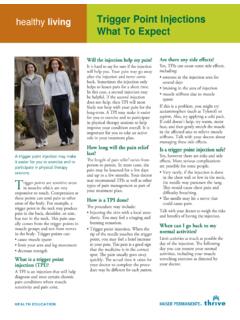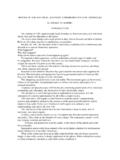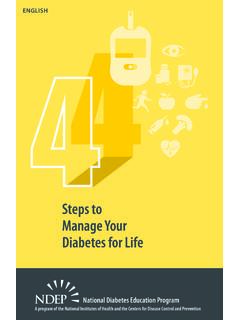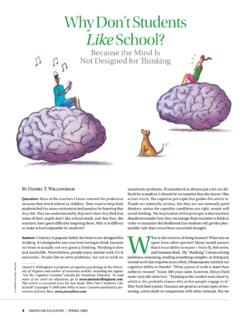Transcription of EMOTION REGULATION HANDOUT 1 - Kaiser Permanente
1 ; p. 271 EMOTION REGULATION HANDOUT 1 ( EMOTION REGULATION Worksheet 1) Goals of EMOTION REGULATION UNDERSTAND AND NAME YOUR OWN EMOTIONS Identify (observe and describe) your emotions. Know what emotions do for you. Other: DECREASE THE FREQUENCY OF UNWANTED EMOTIONS Stop unwanted emotions from starting in the first place. Change unwanted emotions once they start. Other: DECREASE EMOTIO NAL VULNERABILITY Decrease vulnerability to EMOTION mind. Increase resilience, your ability to cope with difficult things and positive emotions.
2 Other: DECREASE EMOTIO NAL SUFFERING Reduce suffering when painful emotions overcome you. Manage extreme emotions so that you don t make things worse. Other: From DBT Skills Training Handouts and Worksheets, Second Edition, by Marsha M. Linehan. Copyright 2015 by Marsha M. Linehan. Permis-sion to photocopy this HANDOUT is granted to purchasers of DBT Skills Training Handouts and Worksheets, Second Edition, and DBT Skills Training M anual, Se c ond Ed ition, for personal use and use with individual clients only. (See page ii of this packet for details.) ; pp.
3 275 278 EMOTION REGULATION HANDOUT 3 ( EMOTION REGULATION Worksheets 2 2c) What Emotions Do for You EMOTIONS MOTIVATE (AND ORGANIZE) US FOR ACTION Emotions motivate our behavior. Emotions prepare us for action. The action urge of specific emotions is often hard-wired in biology. Emotions save time in getting us to act in important situations. Emotions can be especially important when we don t have time to think things through. Strong emotions help us overcome obstacles in our minds and in the COMMUNICATE TO (AND IN FLUENCE) OTHERS Facial expressions are hard-wired aspects of emotions.
4 Facial expressions communicate faster than words. Our body language and voice tone can also be hard-wired. Like it or not, they also communicate our emotions to others. When it is important to communicate to others, or send them a message, it can be very hard to change our emotions. Whether we intend it or not, our communication of emotions influences COMMUNICATE TO OURSELVES Emotional reactions can give us important information about a situation. Emotions can be signals or alarms that something is happening.
5 Gut feelings can be like intuition a response to something important about the situation. This can be helpful if our emotions get us to check out the facts. Caution: Sometimes we treat emotions as if they are facts about the world: The stronger the EMOTION , the stronger our belief that the EMOTION is based on fact. (Examples: If I feel unsure, I am incompetent, If I get lonely when left alone, I shouldn t be left alone, If I feel confident about something, it is right, If I m afraid, there must be danger, I love him, so he must be OK.)
6 If we assume that our emotions represent facts about the world, we may use them to justify our thoughts or our actions. This can be trouble if our emotions get us to ignore the facts. From DBT Skills Training Handouts and Worksheets, Second Edition, by Marsha M. Linehan. Copyright 2015 by Marsha M. Linehan. Permis-sion to photocopy this HANDOUT is granted to purchasers of DBT Skills Training Handouts and Worksheets, Second Edition, and DBT Skills Training M anual, Se c ond Ed ition, for personal use and use with individual clients only. (See page ii of this packet for details.)
7 EMOTION REGULATION HANDOUT 4 ( EMOTION REGULATION Worksheets 3, 1621, 397. 2p; p) What Makes It Hard to Regulate Your Emotions IBIOLOGY Biological factors can make EMOTION REGULATION harder. LACK OF SKILL Yo u d o n t k n ow w h at to d o to re g u l ate yo ur e m ot i o n s. REINFORCEMENT OF EMOTIONAL BEHAVIOR Your environment reinforces you when you are highly emotional. MOODINESS Your current mood controls what you do instead of your Wise Mind. Yo u d o n t rea ll y wa nt to p u t i n t i m e a n d ef for t to re g u l ate yo ur e m ot i o n s.
8 EMOTIONAL OVERLOAD High emotional arousal causes you to reach a skills breakdown point. Yo u c a n t fo ll ow s k ill s i n s tr u c t i o n s or fi g ure o u t w h at to d o. EMOTIO N MYTHS Myths ( , mistaken beliefs) about emotions get in the way of your ability to regulate emotions. Myths that emotions are bad or weak lead to avoiding emotions. Myths that extreme emotions are necessary or are part of who you are keep you from trying to regulate your emotions. I I I IIFrom DBT Skills Training Handouts and Worksheets, Second Edition, by Marsha M.
9 Linehan. Copyright 2015 by Marsha M. Linehan. Permis-sion to photocopy this HANDOUT is granted to purchasers of DBT Skills Training Handouts and Worksheets, Second Edition, and DBT Skills Training M anual, Se c ond Ed ition, for personal use and use with individual clients only. (See page ii of this packet for details.) ; pp. 281 282r -I I I .._ _____ J~-------_ - - - - - -.,,,,. , I I / ' I ' ..,,,,. ------ I 1 __ ; _.
10 I t EMOTION REGULATION HANDOUT 5 ( EMOTION REGULATION Worksheets 4, 4a) Model for Describing Emotions (Thoughts/beliefs about prompting event) Biological Changes Brain changes (neural firing) Nervous system changes (internal body changes that affect muscles and autonomic system firing blood vessels, heart rate, temperature) Experiences Body sensations (feelings) Action urges Expressions Face and Body Language (facial expression, posture, gestures, skin color) Words (what you say) Actions (your behavior) Preexisting Vulnerability Factors Interpretation Prompting EventAttention/Awareness Attention/Awareness Prompting Event 2 Secondary Emotions Aftereffects EMOTION Name Awareness From DBT Skills Training Handouts and Worksheets, Second Edition, by Marsha M.


















